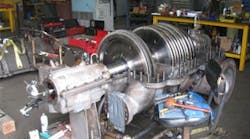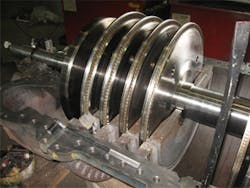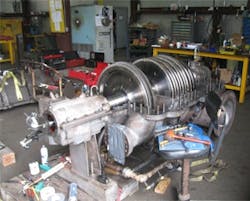Mechanical or electrical trip system testing?
In brief:
- An overspeed failure on a big steam or gas turbine is one of the most frightening industrial accidents.
- A turbine overspeed accident can be caused by a lightning-induced power surge, a fouled pilot valve, an electrical fault, operator failure, or any of a few dozen other problems.
- The trip mechanisms on most turbines are required by law to be tested periodically.
Figure 1. This open view of a turbine shows the close fit between the wheels and the housing on a smaller Elliot E-Line steam turbine. If the rotational speed of the turbine exceeds the safe operating limits of the unit, the main shaft and impeller wheels can be pulled apart by centrifugal force.
Most industrial jobs bring with them a few potential mishaps that can keep a conscientious technical person awake at night. For operations and technical support people who look after large steam or gas turbines, overspeed failures can provide frequent nightmares.
An overspeed failure on a big steam or gas turbine is one of the most frightening industrial accidents. A huge amount of thermal, chemical, and mechanical energy courses through a big turbine when it runs. If the rotational speed of the turbine exceeds the safe operating limits of the unit, the main shaft and impeller wheels can be pulled apart by centrifugal force. In the worst case, the disintegrating parts can break through the turbine housing, flinging hot, fast-moving shards of metal in all directions. The results of such a failure are always very costly and can be fatal to personnel in the area (Figure 1).
A turbine overspeed accident can be caused by a lightning-induced power surge, a fouled pilot valve, an electrical fault, operator failure, or any of a few dozen other problems. Turbines are equipped with shutoff systems that are designed to automatically stop them if they exceed the design speed. These systems are built to cut the energy supply to the turbine so that it will coast to an orderly stop. Such a stop is usually referred to as a “trip” by operating staff.
The trip mechanisms on most turbines are required by law to be tested periodically. Turbines up to 100 hp are typically tested annually, says Ron Reeves, manager/partner at Turbonetics Engineering & Services (testexas.com) in Corpus Christi, Texas. The largest units, which may run as long as five years between shutdowns, should be tested whenever they are taken out of service.
Operators face a quandary with regard to testing trip systems on large turbines. One way to perform the test is to use electrical or other mechanisms to mimic an overspeed situation. In this way, the turbine can go through the shutdown sequence without risking an actual overspeed event. This approach, while it seems safer, doesn’t test all parts of the trip mechanism. The other approach is to actually bring the turbine to an overspeed situation and let the actual trip mechanism activate and cause a shutdown. This is a more complete test, but it brings the turbine closer to a dangerous overspeed situation.
Turbine people are divided on the choice of test approach. One faction cites the importance of keeping the turbine out of an overspeed situation. The other points to the risk of not testing the entire trip mechanism.
A field service perspective
Turbonetics’ Reeves says he’s “pro-functional test,” meaning the wiser course is to test the whole trip mechanism. “The trip system may include mechanical, hydraulic, and electronic systems, all working as a unit,” he says. “I want to see them all function together.”
Figure 2. If a trip fails to happen, shut the turbine down and find out why it didn’t trip. Most of the components can be individually tested off the machine to help with the diagnosis.
As to the risk of actually running the turbine beyond its normal operating speed, the answer is planning and control, explains Reeves. “You don’t just pour the power to the turbine,” he says. “You have to sneak up on the overspeed. You uncouple the turbine from all loads to minimize the energy in the system and then accelerate gradually to normal operating range. Beyond that, you add steam or fuel a very little bit at a time, stabilizing the system each step of the way, even if you have to connect a smaller feed to provide more delicate control. Remember, an accelerating system has momentum. It won’t necessarily stop accelerating as soon as you stop adding power.”
Working with your equipment manufacturer helps to develop a procedure for the test that is just as detailed as your operating procedures for normal work, explains Reeves. “Agree on the maximum speed you will allow and don’t exceed it, even if a trip doesn’t happen,” he says. “Shut the turbine down, if you have to, and find out why it didn’t trip. If need be, most of the components can be individually tested off the machine to help with the diagnosis (Figure 2). All the new electronics are great, but I still want to see the real trip system do its job, so I know it will work when the regular operators are in charge.”
An insurance perspective
Edward Clark is assistant vice president of Starr Technical Risks (starrcompanies.com), a property insurance company that insures petroleum refinery, petrochemical, and power generation plants. “My job is loss prevention and risk assessment” he says.
Clark offers the financial loss control picture for overspeed failures. “From a property insurance viewpoint, an overspeed event can destroy the case of a steam turbine and/or the driven object, the equipment,” he explains. “Since cases are not typically carried as spare parts, an overspeed event can result in a very large business-interruption insurance claim, in addition to a claim for the cost of the destroyed steam turbine and its driven object.”
As an insurer, Clark exhibits a preference for newer, electronic safety controls. “For many years, I have advocated replacing mechanical governors and mechanical overspeed protection devices with electronic governors and electronic overspeed protection systems,” he offers. “The electronic governor and electronic overspeed protection system must be installed in strict accordance with API 612 and API 670. If a steam turbine has a mechanical overspeed trip device, it should be tested at least annually. If a steam turbine has an electronic overspeed protection system, that system is typically designed to be tested while the turbine is in normal operation by electronically sending an overspeed signal to the system. That tests the electronic components; it does not test the trip throttle valve, or main steam stop valve, if so equipped. We suggest this type of test be done quarterly.”
| J. Stanton McGroarty, CMfgE, CMRP, is senior technical editor of Plant Services. He was formerly consulting manager for Strategic Asset Management International (SAMI), where he focused on project management and training for manufacturing, maintenance and reliability engineering. He has more than 30 years of manufacturing and maintenance experience in the automotive, defense, consumer products and process manufacturing industries. He holds a bachelor of science degree in mechanical engineering from the Detroit Institute of Technology and a master’s degree in management from Central Michigan University. He can be reached at [email protected] or check out his Google+ profile. |
Clark agrees with Reeves on the subject of minimizing the energy in a system under test, but takes a somewhat different approach to energy reduction. “We have no preference on the testing speed; testing at reduced speed is OK,” he says. “When possible, such as during or just before turnarounds, testing at or just above normal operating speed would be desirable. At that time, the turbine trip valve could also be included in the test.”
Testing the turbine with no load should not be done, if possible, recommends Clark. “However, testing a mechanical overspeed trip system on a turbine driving a pump or compressor can normally only be done with the turbine uncoupled from the driven object,” he says. While Clark prefers testing under load, he acknowledges the need for no-load testing on most large equipment.
“Trip throttle valves, turbine trip valves, governor valves, and steam extraction check valves should be exercised at least weekly to reduce the probability of the valve sticking due to steam deposits on the valve stems,” suggests Clark, who agrees with Reeves about the importance of carefully developed and documented procedures. “All testing of turbine systems, mechanical or electronic, should be done in strict accordance with well-written, comprehensive, formal procedures,” he says. “All persons performing the tests should be well-trained and qualified.”
Clark recommends testing below the overspeed range. “Properly designed electronic governors and electronic overspeed protection systems are more reliable than mechanical systems,” he explains. “Testing a mechanical overspeed trip system at speed is relatively dangerous for personnel.”


